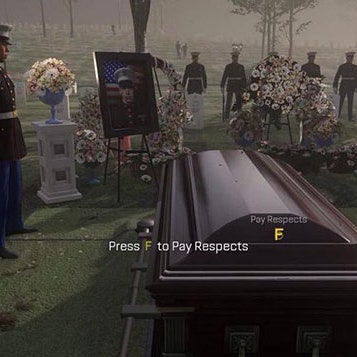What’s the worst trend in gaming?
I don’t know. But the most inexplicable trend is the game that doesn’t want you to play it.
You are led by the nose down a path, having scripted experiences. Every choice has been made for you in advance. Stray from the path and you’re corralled back in by invisible walls or flashing “RETURN TO THE BATTLEFIELD” messages. Cutscenes are immensely long: you spend half the game with your inputs disabled.
Any “interactivity” is inconsequential: you can choose from two paths in the road, but both lead to the same destination. You can choose from two options in an NPC dialog tree, but the conversation ends the same way every time.
…Doesn’t this defeat the whole purpose of a videogame? Being able to explore and interact and express agency? Games lose a lot when they’re reduced to booklike narratives where the player’s “actions” are just fancy ways of turning the page.

This is not a “games were better in my day!” rant. The worst offenders in this category are actually classic games, particularly the adventure games of the 80s and 90s.
Remember adventure games? Like The Secret of Monkey Island and Leisure Suit Larry? Remember how, around 1995-1996, everyone suddenly stopped playing them?
“The death of adventure games” was a popular journalistic brief in the late 90s. Writers filed many a column inch about why adventure titles weren’t selling, and why the old guard of developers (Sierra/LucasArts/Trilobyte) were either shifting focus or filing for bankruptcy.
Always, an outside factor is blamed for killing the genre. Adventure gamers love Lost Cause myths where their beautiful, pure genre were ruined by Myst and Doom and Nintendo and arcades. Nobody wants to admit that the rot started within.
Here’s the truth: most adventure games (aside from a short list of classics) were actually total shit, full of illogical puzzles, mazes, pixel hunts, fetch quests, and arbitrary deaths. Here’s the average puzzle in a text adventure:
You are hungry! You find a HAM SANDWICH and a
TURKEY SANDWICH. What do you do?
>EAT HAM SANDWICH.
You are dead! It was a POISON HAM SANDWICH! Should have gone with the turkey, dumbfuck! Load save Y/N?
That’s not a strawman. Half the games Infocom ever made were exactly like that.
Just because I love you, here’s a real example from Westwood’s critically-acclaimed The Legend of Kyrandia, which sold quarter of a million copies in 1996.

Imagine this:
You are standing outside a house, looking down into a lake. You see a pair of eyes in the water. When you approach the water’s edge to get a better look, a huge monster rises from the water, snatches you with its tongue, and reels you into its mouth. Crunch.
Terrible. A whole Full Sail game design course could be taught about how utterly bad this puzzle is, in every conceivable way.
There’s no warning of danger, no possibility of escape, and the outcome for the player is death. There’s no skill involved: you just have to know not to follow the eyes. And since you can’t anticipate the next death trap (which there are a lot of), you end up creeping around Kyrandia like a scared mouse, hoping you don’t step on any Instant Death Pixels(tm).
The Legend of Kyrandia actively penalizes you for playing it. Exploring? Taking risks? That’s not in the plan. Stick to the main path, friendo, and do what the game wants you to do.
This design approach is great from the developer’s point of view. You spend less time designing art assets and playtesting puzzles. Your games ship sooner, and have fewer bugs. Open-world games with a lot of options quickly turn into a garden of forking paths. But in the long run, you get a constrained experience.
It’s interesting that the big genre shifts of the past few years have included open-world exploration games like Minecraft, and battle royales like Fortnite and Apex Legends. These are games where every experience is different. It’s not a surprise, in hindsight. Players, by definition, want to play. They don’t want to be conscripted characters in someone else’s story, and that’s exactly what many major games are.
I’ve long felt that the “are videogames art?” debate elides the obvious point that the “art” of videogames is usually just cinema, at best. Playing a Triple-A game is largely indistinguishable from watching a movie. The strongest claim games can make to being an art form are titles like Cosmology of Kyoto and Rez…
…obscure, nice products that nobody’s heard of.
No Comments »
“…putting Sade back on the bookshelf” is how Le Figaro describes this book. If anyone has A Sentimental Novel on their bookshelf, it’s with a fake cover, the spine turned inward, and probably an explosive self-destruct device fitted so the the book can be safely 451’d if the police come knocking.
Robbe-Grillet’s final work is short and lacks a narrative. It’s a sequence of pornographic vignettes, where nymphets of questionable legality are defiled by middle-aged male châtelains exactly like the author (don’t ask questions). This is the kind of book where you hear the word “nubile” and the author isn’t trying to be funny.
On one hand, I approve of books written by maniacs. On the other, the world has moved past the Marquis de Sade, and Robbe-Grillet just retreads familiar ground for the most part. It’s well-written (or flattered in translation), but to what end? Bataille, Huysman, and Comte de Lautréamont wrote far more imaginative and creative work a century ago, and they lived a century ago. Robbe-Grillet spent a lifetime championing le nouveau roman. Was he trying to champion le vieux romain, too?
A Sentimental Novel is hard to analyse. Airy and light. Floaty. There’s an intentional lack of substance to the book that makes it strangely affecting, but which also renders it averse to study. Barthes described Robbe-Grillet’s style as “a theory of pure surface” (or I think he does – I can’t find a source for this quote), and that’s very evident: A Sentimental Novel is a neverending plain of surfaces, with your eye forever bouncing off them. The prose displays everything, but displays nothing. We get descriptions of reflections glissading across a set of shears as they snip away a nipple. Whose shears? Whose nipple? Why? It’s all heat. No light.
In this sense, at least, Robbe-Grillet leaves his inspiration behind. Donatien Alphonse François’s books were always clearly about something: they’re notoriously full of political and philosophical rants (to the point where they’re turgid and boring). But a critic will have to dig very deep to find meaning in A Sentimental Novel, and any interpretation is probably 90% critic, 10% book.
I’m personally not impressed by writers that word-vomit imagery and burden the reader with the task of “interpreting” it. It’s not that the author is lazy (effort doesn’t matter in art. It’s not weightlifting). It’s that if the meaning is all coming from my own mind, why do I need Alain Robbe-Grillet in the picture? I enjoy thinking about books, and analyzing them, but I’d ask that the author at least meet me halfway by taking responsibility for the things on the page. A Sentimental Novel could be a Sade written by a computer. There’s no crests, no rises and falls, no build-ups, nothing.
I’m sure that if I stare at A Sentimental Novel for long enough, I’ll discover its genius. I’m also sure that if I stare at a piece of toast long enough I’ll see Jesus’s face.
Does transgressive literature have a future at all? Maybe it’s in the too-gay-to-function Dennis Cooper, the computer-mangled sentences of Kenji Siratori, the alt-lit of the web, the heart-freezing paralysis of Michel Houellebecq. Writers who are doing something new, however incompetently.
Even average writers like Palahniuk and Ellis are able to find new angles to exploit, such as capitalism, mass media, and so on. They’re not just rewriting Sade for the millionth time. Meanwhile, here’s Robbes-Grillet toiling alone in an abandoned mine, seeking gold in a shaft that was mined out a century ago.
No Comments »
This 1821 book introduces one of the most famous and well-loved heroes in fiction. It stars in Junky by William Seward Burroughs, Trainspotting by Irving Welsh, Fear and Loathing in Las Vegas by Hunter S Thompson, and Requiem for a Dream by Hubert Selby, and countless others besides.
You’ll find the book’s hero in a green pod behind the amaranthine petals of a Papaver somniferum poppy plant. The resin inside the pod is called opium, and it contains the analgesic alkaloid known as morphine. When this alkaloid is ingested, injected, or snorted, it attaches itself to receptors in nerve cells, inhibiting neurotransmitter release, and giving you a pretty good weekend in Vegas.
Opioids have uses, but they’re also dangerous. Take enough, and you forget to feel pain. That’s the plan. Take too much, and you literally forget to breath. Sometimes that’s the plan, too.
“Among the remedies which has pleased the Almighty God to give to man to relieve his sufferings, none is so universal and so efficacious as opium” – Physician Thomas Sydenham (1624-89)
Opium (whether smoked or consumed in the liquid form of laudanum) was the cat’s pajamas in Romance-Era Britain. It was an effective painkiller in a world with a lot of pain. Additionally, it was fashionable: Romantic writers tended to view it as a gateway to a mystical oriental experience that only a cultured and wordly mind could appreciate.
But many opium users were clearly addicts. Confessions of an English Opium Eater is a rare bird: a Romantic account written by an ex-addict with the self awareness to know it.
It’s not packed with outrageous sin and depravity. Nor is full of incoherent drooling about the divine fractal oneness of the cosmos (etc etc). It’s a conventional narrative, and some of the most fascinating parts don’t involve drugs at all. You’ll learn a lot about how things were in England at the time, or at least I did.
The beginning section describes the author’s early life and matriculation, followed by his descent into poverty and homelessness that’s basically self-inflicted (he picks a fight with a bishop who he believes has insulted him, and loses his lodgings). He subsists at the margins of society, eating berries and earning money by writing love letters for illiterate young people. Apparently you could make a living doing that at one point.
De Quincey writes affectingly of the conditions affecting London’s lower classes, particularly orphans and prostitutes. A lot of the book could be viewed as proto-Dickensian. There’s a terrifying sense of atomization to this dark gaslit world that has no modern parallel – once De Quincey loses track of a person, he can usually never find them again. Friends just disappear, like they were never there. These people have no fixed address, no way of receiving mail, and sometimes not even a surname. But they’re loyal to each other – often De Quincey gets out of trouble with the police because a helpful urchin or streetwalker vouches on his behalf.
His fortunes improve at the intercession of some moneylending Jews, and while trying to establish a trade, he winds up on Oxford Street, buying opium to help the pain of a toothache (ironically, he becomes an addict perfectly legally, and only after he escapes the underground). He describes his first dose like this:
I took it—and in an hour—oh, heavens! what a revulsion! what an upheaving, from its lowest depths, of inner spirit! what an apocalypse of the world within me! That my pains had vanished was now a trifle in my eyes: this negative effect was swallowed up in the immensity of those positive effects which had opened before me—in the abyss of divine enjoyment thus suddenly revealed.
“Abyss of divine enjoyment” is both paradoxical and religious in tone. But drugs are paradoxes, combining the holy and profane. They midwife beautiful literature, midwife insanity and necrotizing fasciitis. And the religious connotations aren’t strange: religious ecstasy and drug trips look very similar to the outsider, and perhaps the psychological effects are similar.
Across the Atlantic, the Civil War was brewing, where countless tons of opium would be used to treat battlefield injuries. It would be called “God’s Own Medicine”. Later doctors would refer to opium’s primary alkaloid as morphine, after Morpheus, Ovid’s God of sleep and dreams. The last and most devastating of opium’s children is heroin, derived from hero, who were traditionally men with divine ancestry. Drugs are debased spirituality inside a dirty needle.
De Quincey’s tail leads us on in familiar directions. Higher dosages. Higher thrills. He takes 1,000 drops of laudanum a day! He reads Kant, and actually understands him! There’s some great writing about his drug-created hallucinations. These have potential to drag, but they’re kept brief enough that they don’t. If the first section is proto-Dickens, the second is proto-Timothy Leary.
But things start going bad. The dreams become extremely disturbing nightmares.
The waters now changed their character—from translucent lakes shining like mirrors they now became seas and oceans. And now came a tremendous change, which, unfolding itself slowly like a scroll through many months, promised an abiding torment; and in fact it never left me until the winding up of my case. Hitherto the human face had mixed often in my dreams, but not despotically nor with any special power of tormenting. But now that which I have called the tyranny of the human face began to unfold itself. Perhaps some part of my London life might be answerable for this. Be that as it may, now it was that upon the rocking waters of the ocean the human face began to appear; the sea appeared paved with innumerable faces upturned to the heavens—faces imploring, wrathful, despairing, surged upwards by thousands, by myriads, by generations, by centuries: my agitation was infinite; my mind tossed and surged with the ocean.
De Quincey might have actually killed a man in this period. While on an opium trip, a Malaysian gentleman knocks upon his door. Neither of them can talk to each other, but as a show of brotherhood, De Quincey hands him a large slab of opium.
I was struck with some little consternation when I saw him suddenly raise his hand to his mouth, and, to use the schoolboy phrase, bolt the whole, divided into three pieces, at one mouthful. The quantity was enough to kill three dragoons and their horses, and I felt some alarm for the poor creature; but what could be done? I had given him the opium in compassion for his solitary life, on recollecting that if he had travelled on foot from London it must be nearly three weeks since he could have exchanged a thought with any human being. I could not think of violating the laws of hospitality by having him seized and drenched with an emetic, and thus frightening him into a notion that we were going to sacrifice him to some English idol. No: there was clearly no help for it. He took his leave, and for some days I felt anxious, but as I never heard of any Malay being found dead, I became convinced that he was used to opium; and that I must have done him the service I designed by giving him one night of respite from the pains of wandering.
Was the Malaysian man really “used to opium”? Or was this a self-serving fiction to ease a guilty conscience? Whatever happened to the Malaysian man, he returns to haunt De Quincey’s nightmares, along with a host of other spectres.
The inevitable part where he hits rock-bottom is dealt with only briefly. That’s my main issue: the tale feels lopsided and front-heavy, giving too much weight to his lodging disputes while neglecting the story’s main thrust of addiction. In a later edition, he expands his experiences, but apparently the earlier version is the better one. More words doesn’t always equal more meaning, as any reader of Stephen King can tell you.
So, an interesting read, and an educational one, but perhaps not always a truthful one. I’ve always wondered how much of a drug experience comes from the user, instead of the drug. Thanks to the placebo effect, drugs can be a self-fulfilling prophecy. Haven’t we all seen someone at a party drink one beer and suddenly start slurring his speech and groping girls’ asses? He’s not drunk. He just thinks he’s drunk. He’s granting himself permission to let go. The beer could have been tablewater – all it really did was act as an emotional go sign.
De Quincey didn’t know of the placebo effect, but he was aware that drug experiences are idiosyncratic toward the user.
If a man “whose talk is of oxen” should become an opium-eater, the probability is that (if he is not too dull to dream at all) he will dream about oxen; whereas, in the case before him, the reader will find that the Opium-eater boasteth himself to be a philosopher; and accordingly, that the phantasmagoria of his dreams (waking or sleeping, day-dreams or night-dreams) is suitable to one who in that character.
Roland Fisher famously described Aldous Huxley’s 1954 drug book The Doors of Perception as “99 percent Aldous Huxley and only one half gram mescaline”. The same might be true for De Quincey’s adventures, over a hundred years earlier. The fault, in the end, lies not in our doors, but in ourselves.
The God, uneasy ’till he slept again,
Resolv’d at once to rid himself of pain;
And, tho’ against his custom, call’d aloud,
Exciting Morpheus from the sleepy crowd:
Morpheus, of all his numerous train, express’d
The shape of man, and imitated best;
The walk, the words, the gesture could supply,
The habit mimick, and the mein bely;
Plays well, but all his action is confin’d,
Extending not beyond our human kind.
Another, birds, and beasts, and dragons apes,
And dreadful images, and monster shapes:
This demon, Icelos, in Heav’n’s high hall
The Gods have nam’d; but men Phobetor call.
A third is Phantasus, whose actions roul
On meaner thoughts, and things devoid of soul;
Earth, fruits, and flow’rs he represents in dreams,
And solid rocks unmov’d, and running streams.
These three to kings, and chiefs their scenes display,
The rest before th’ ignoble commons play.
Of these the chosen Morpheus is dispatch’d;
Which done, the lazy monarch, over-watch’d,
Down from his propping elbow drops his head,
Dissolv’d in sleep, and shrinks within his bed.
The Metamorphosis, Book the Eleventh 11:891 Ovid
No Comments »





